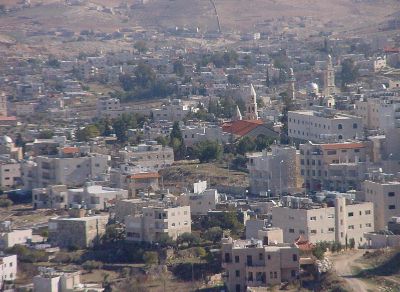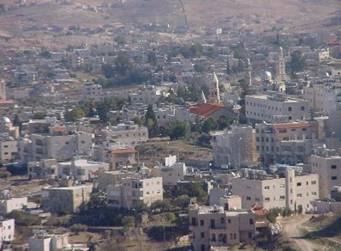
There are two towns in close proximity to Bethlehem: Beit Sahour and Beit Jala, each with a population of 14,000 inhabitants. Today, they seem like extensions of Bethlehem; no municipal boundaries divide them. The Shepherds' Field is located in Beit Sahour (the house of vigilance). Its name reportedly stems from the Canaanite words ”beet” meaning place, and ”Sahour” meaning night watch. The name reflects the town's importance for shepherds as a grazing site during day-time and the safety of the abundant caves offered to the flocks at night. It has a pastoral setting and the olive groves dominate the horizon. This town can be reached on foot from Bethlehem by way of the Milk Grotto street. Visitors can observe here the general slope of the land eastward, on the farthest decline of which lies the town, and how it finally terminates in a small plain in the midst of which lies the shepherds' field.

Beit Sahour has origins going back to the Bronze Age (3000 B.C.) The Canaanites inhabited its numerous caves. Traces of inhabitants were found in caves, going back to Roman times. The remnants of very ancient oil presses found under the foundations of the two monasteries, demonstrate beyond every doubt that the place was inhabited at the time when Jesus was born in Bethlehem. Oral traditions still in circulation assert that many Christian families who came from Yemen and Wadi Musa in Jordan in the middle of the 14th century took shelter in Beit Sa-hour. In the sixteenth century, houses rose up the mountain slope between the shepherds' field and the Nativity hill. Then, it spread to the site of the present Municipal Market near ”Bir-Essyydah” the Well of Mary.
Today, Beit Sahour is a Christian town with a Muslim minority. It is a middle class place and a thriving town with many industries: plastics, olive wood, clothing and mother-of-pearl. The town center has narrow thoroughfares, with houses built of polished sandstone, parts of which date back to the sixteenth and seventeenth centuries. Some of its roads are topped by rocky arches supported by the house walls, reflecting the charm of the architecture in those days. The buildings are rarely more than two or three stories high. Modern Beit Sahour has many beautiful villas and buildings with many stories.
Beit Sahour is the home of many fine churches. The Latin Patriarchate has a church with a very ornate altar, built in 1859. The church was erected by Father Jean Muretan. In 1951, it was completely transformed by Arch. A. Barluzzi and was consecrated and dedicated to our Lady of Fatima and St. Theresa of Lisieux. The fine portico of the church has three pointed arches; the upper part of the façade is crowned by a flight of slender little arches which also run along the side walls. The inside is divided into a nave and two aisles by two rows of four columns each. The very narrow pointed arches create the illusion that the inside is longer than it actually is. The main altar is especially worth mentioning. In spite of its size, it looks like an ivory miniature rather than carved stone. The frontal and the upper part of the altar are decorated with 15 panels representing various scenes from the Annunciation to the arrival of the Holy Family in Egypt. At the same level at the tabernacle, there are four little statues of the Evangelists; in the upper part, the 12 Apostles surround the image of Christ. Builders of this work were Palestinian artists from the town. Near the church there is a school run by the Rosary Sisters, as well as a large hall for the parish activities, and a club for the parish scouts.
Within the town, there is a Greek Orthodox church built in 1897. The Greek Orthodox represent the majority of the population. Before this church was built, the underground church in the Shepherds' field was used. Another church was built in 1972 near the site of the Shepherds' Field, and a new secondary school was built in 1990 adjacent to the church. The Arab Orthodox Club is the oldest club in the town; it was founded in 1924 and its scout group is the largest in town.

The Greek Catholic community represents 15% of the population. They have a church, a school and a small seminary run by the Salvatorian Fathers of Lebanon and the Salvatorian Sisters who arrived in 1958 to look after the seminary. The Lutherans have a church and a secondary school established since 1901. Adjacent to the school is the Center of Alternative Tourism. The Muslims have a mosque, built in 1954, and the Islamic Society runs a nursery, a cultural center and two clubs. In Beit Sahour there are three boy scout groups and different clubs for youth. One club is a Cultural Center for the Children, initiated in 1992 by a group of women to develop the child's cultural and intellectual abilities.
Among the most important institutions and centers in Beit Sahour are: The Fashion and Textile Institute, founded in 1994 as a leading institute in the field of training middle cadres for the garment industry. Training is offered in fashion design and pattern making. There is also a Palestinian Center for Public Opinion, founded in 1994, dedicated to conducting public opinion surveys. The center holds seminars and workshops on topics of interest to the public to enhance their awareness of human rights.
The inhabitants of Beit Sahour were widely known during the Intifada in 1988, for their tax resistance movement against the Israeli occupation. When the tax disobedience started, the inhabitants raised the slogan No Taxation Without Representation; the same slogan the Boston Tea Party raised. The occupation authorities began an all-out campaign to crush the tax resistance with widespread raids, arrests, curfews and confiscation of commercial and private properties of the people of Beit Sahour. The curfew lasted forty-five days. In the last days a resolution was introduced in the United Nations Security Council calling upon Israel to stop the tax raids and to return all the confiscated goods, which were never returned.